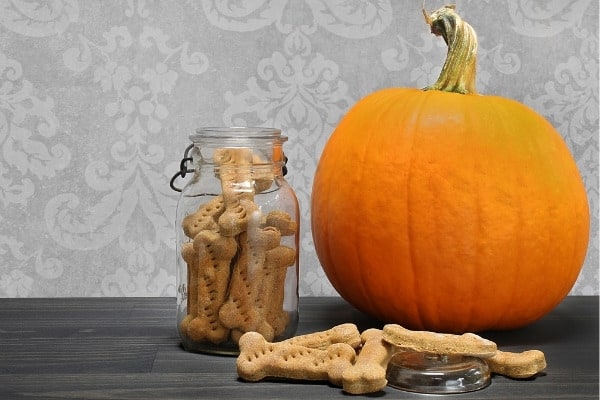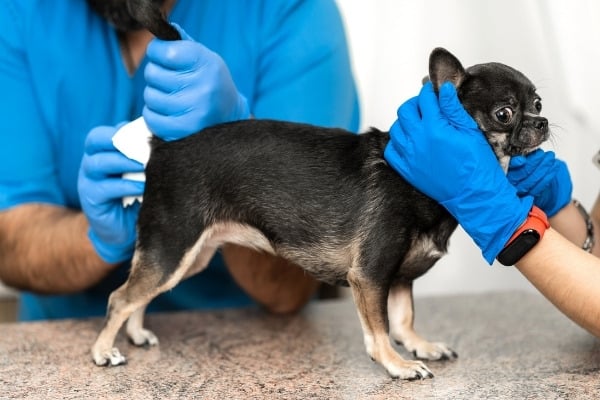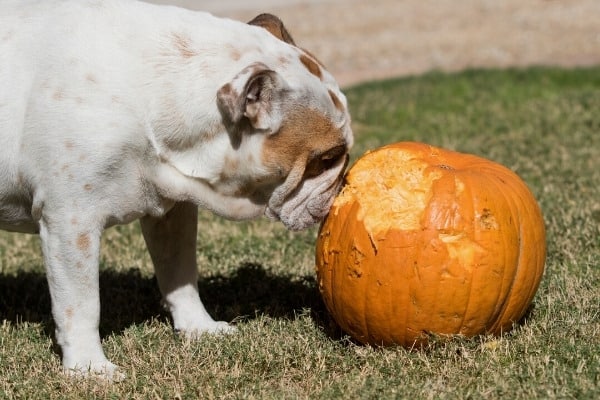
Dogs have two small sacs of fluid in the rectum called anal glands. These glands serve a few different purposes, but they can also become swollen, painful, and itchy.
If your dog has anal gland problems or if your dog has had anal gland problems in the past, you may be looking for ways to treat the problem.
Pumpkin can help add fiber to your dog’s diet, reduce constipation and diarrhea, and help reduce anal gland problems.
Does pumpkin help a dog’s anal glands? Pumpkin contains a lot of fiber and can help keep your dog’s stool soft to reduce straining that can cause inflammation and irritation in the rectum and prevent pressure on the anal glands. Pumpkin can also help reduce impaction and itching. Just be sure to only feed plain, unseasoned pumpkin.
If your dog has issues with his anal glands and you are wondering if there is anything you can do the resolve the issues, read on to learn more.
Anal Glands in Dogs
If your dog seems to be rubbing his bottom on things or trying to lick and bite at his nether region, he could be suffering from issues with the anal glands that are located inside a dog’s rectum.
What Are Anal Glands?
Anal glands are located inside of your dog’s rectum on both sides. They release a scent that makes your dog identifiable to other dogs.
They can become inflamed and impacted, which can be painful and itchy for your dog.
Why Do Dogs Have Anal Glands?
Dogs have anal glands for several reasons. They help release lubrication that makes it easier for your dog to pass stools.
They also release a scent that allows dogs to produce markings, and they can release pheromones that attract mates.
Why Do Some Dogs Have Anal Gland Trouble?
Sometimes a dog can have anal glands that become blocked and start to itch or become painful. Inflammation in the dog’s rectum caused by constipation and straining can also irritate the anal glands.
Being overweight can hinder the normal emptying of the anal sacs, so be sure to monitor your dog’s weight, feed a healthy diet, and provide plenty of daily exercise.
Blocked Anal Glands in Dogs
Blocked anal glands are common in dogs. The blockages can be caused by a number of things, including food allergies, irritation, constipation, infection, and diarrhea.
If your dog has problems with his anal glands, it’s best to find the cause so you can determine the best treatment.
Anal Gland Infection
Sometimes a dog’s anal glands can become infected. This can occur if the dog has been biting at the area or accidentally scratched it against something and caused an open cut or wound.
Infections can be dangerous and need to be treated with prescription antibiotics by a veterinarian.
Ruptured Anal Gland in Dogs
When anal glands become impacted and the pressure is not released, it can build up and cause the anal glands to rupture.
This can be painful for a dog, but there is not much that can be done medically. Veterinarians may offer antibiotics to prevent an infection and pain medicines to help with discomfort.

How Do You Know If Your Dog’s Anal Glands Are Full?
If your dog’s anal glands are full, they may start to irritate your dog. Your dog may be licking his bottom, be rubbing it on the carpet, or seem to be in pain when he poops.
A veterinarian or groomer will be able to release the pressure in the glands to provide relief and prevent them from rupturing.
Will Feeding Pumpkin Help My Dog’s Anal Gland Trouble?
Feeding a dog pumpkin can help make your dog’s stool more regular and reduce straining, which can lead to inflamed or irritated anal glands.
While pumpkin isn’t a magically cure-all, once your dog’s anal glands have been emptied, adding pumpkin to the diet may prevent future anal problems.
Benefits of Pumpkin for Dogs
Pumpkin is packed with fiber and other nutrients that are very healthy for dogs. It can help improve a dog’s digestion, can relieve both constipation and diarrhea, and can help with stomach pain.
Can I Give My Dog Pumpkin Everyday?
Pumpkin is very healthy for dogs, and as long as you are offering them plain, fresh, canned pumpkin that does not contain any additives, it is safe to feed your dog small amounts of pumpkin every day.
Can Pumpkin Cause Diarrhea in Dogs?
Fresh, plain, canned pumpkin helps to relieve diarrhea in dogs. If the pumpkin contains spices such as cinnamon and nutmeg, it could irritate the dog’s digestive tract and cause diarrhea.
What Kind of Pumpkin for Dogs?

It’s best to only offer plain, fresh pumpkin to your dog. You can also use pumpkin as an ingredient with other foods that are safe for dogs to make treats for your dog.
Where To Buy Plain Canned Pumpkin for Dogs
You can buy plain, canned pumpkin at most grocery stores. It is usually located in the same aisle as other canned vegetables and fruits.
Some pet supply stores may also offer canned pumpkin for dogs.
How Much Pumpkin To Give a Dog Daily
Pumpkin is safe for dogs to eat daily in small amounts. The size of your dog and its weight should be considered when choosing how much pumpkin to feed him.
How Much Pumpkin for a 60 Pound Dog?
A 60-pound dog can eat up to 6 teaspoons of pumpkin a day.
How To Cook Pumpkin for Dogs
Fresh pumpkin is always the best option to feed your dog. You can cook it by baking the pumpkin in the oven until it becomes soft.
Scoop out the seeds and flesh of the pumpkin and separate them.
The seeds can be toasted and offered to your dog as a crunchy treat, and the flesh of the pumpkin can be cooled and fed to your dog with his food or used in recipes.
You can also feed your dog raw pumpkin flesh, but you shouldn’t feed him raw pumpkin seeds.
Glandex vs. Pumpkin
Both pumpkin and Glandex are safe for dogs and can help reduce inflammation and swelling in your dog’s anal glands.
Glandex contains pumpkin seeds as well as other sources of fiber.
While both can aid in digestion, Glandex contains a more concentrated and premium type of fiber and can be more beneficial to your dog than plain pumpkin or pumpkin seeds.
- SUPPORTS HEALTHY ANAL GLANDS: Glandex is scientifically formulated to support healthy anal glands....
- GUARANTEED TO BOOT THE SCOOT: Glandex results are guaranteed to help your pet "Boot the Scoot!” in...
Related Questions:
Can Dogs Have Pumpkin Seeds?
Dogs can have pumpkin seeds as long as they are cooked. Toasted pumpkin seeds can be a crunchy treat for your dog, and they have nutritional value as well.
Can Dogs Have Pumpkin Pie?
Dogs should not eat pumpkin pie. There are many different ingredients in pumpkin pie that can be harmful to dogs.
Spices such as cinnamon and nutmeg can irritate a dog’s digestive tract. Other ingredients such as butter, milk, salt, sugar, and eggs can also be unsafe for dogs to eat.
Wrapping Up
If your dog has impacted anal glands or has a history of anal gland problems, you may be looking to help relieve the discomfort and reduce the risk of an anal gland rupture.
Feeding your dog plain canned, fresh, or cooked pumpkin can improve digestion and help reduce the strain and pressure in your dog’s rectum and around the anal glands.
Last update on 2024-04-19 at 20:03 / Affiliate links / Images from Amazon Product Advertising API





